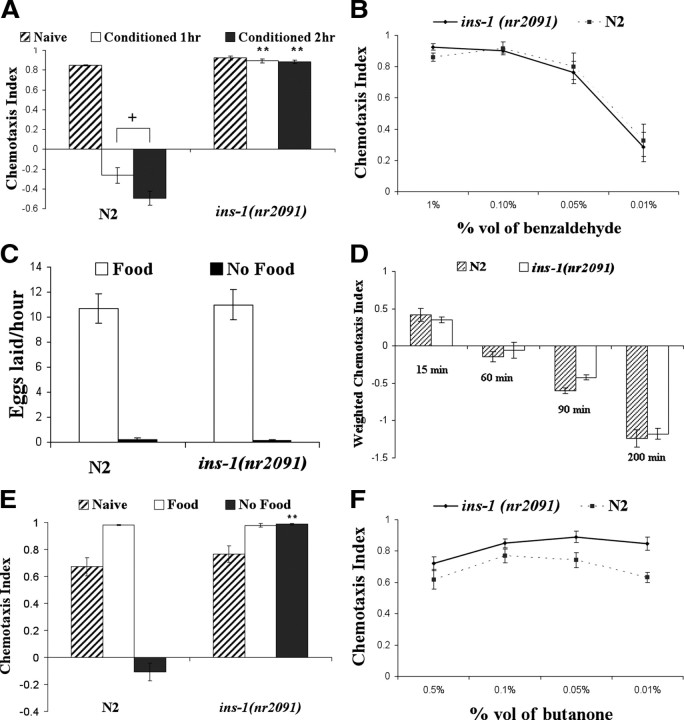Figure 1.
ins-1 mutants are defective in odorant–starvation associative plasticity. For all panels in the figure, double asterisks represent significant differences from N2 within the same experiment (**p < 0.05 by Bonferroni's t test). Crosses represent significant differences between the indicated data points (+p < 0.05 by Bonferroni's t test). Data represent means ± SEM. A, Benzaldehyde–starvation learning in wild-type N2 and ins-1(nr2091) worms. Animals were conditioned to 100% benzaldehyde in the absence of food for either 1 or 2 h and immediately following conditioning, their chemotaxis to 1% benzaldehyde was examined. ins-1 mutants demonstrated significant deficits in benzaldehyde–starvation associative plasticity both after 1 or 2 h of training. A two-way ANOVA revealed a significant interaction between strain and conditioning, F(2,35) = 147.12, p < 0.05 (n = 6 plates for each data point). B, Chemotaxis of N2 and ins-1(nr2091) to various concentration of benzaldehyde. N2 and ins-1(nr2091) were comparable in their chemotaxis to 1, 0.1, 0.05, and 0.01% benzaldehyde, suggesting ins-1(nr2091) animals sense benzaldehyde normally. A two-way ANOVA revealed a main effect of benzaldehyde concentrations, F(3,31) = 37.97, p < 0.05, and no main effect of strain F(1,31) = 0.078, p < 0.05 (n = 4 plates for each data point). C, Number of eggs of N2 and ins-1(nr2091) laid in 1 h on and off food. N2 or ins-1(nr2091) animal was placed on a standard OP50 food lawn or blank NGM agar and the number of eggs laid in 1 h was scored. Starvation suppressed egg laying in both strains. A two-way ANOVA revealed a main effect of food availability, F(1,35) = 155.71, p < 0.05, and no main effect of strain F(1,35) = 0.017, p < 0.05 (n = 12 plates for each data point). D, Chemotaxis of N2 and ins-1(nr2091) to 100% of benzaldehyde at various time points. A two-way ANOVA revealed no main effect of strain F(1,31) = 1.427, p = 0.244 (n = 4 plates for each data point). E, Butanone enhancement and butanone–starvation associative plasticity in N2 and ins-1(nr2091) mutants. Animals were conditioned to 100% butanone in the presence or absence of food for 1 h and tested their chemotaxis to 0.5% butanone. ins-1(nr2091) mutants were normal in butanone enhancement but were defective in butanone–starvation associative plasticity. A two-way ANOVA revealed a significant interaction between strain and conditioning, F(2,35) = 86.82, p < 0.05 (n = 6 plates for each data point). F, Chemotaxis of N2 and ins-1(nr2091) to various concentration of benzaldehyde. A two-way ANOVA revealed no interaction between strain and butanone concentrations, F(3,31) = 0.714, p = 0.53 (n = 4 plates for each data point).

